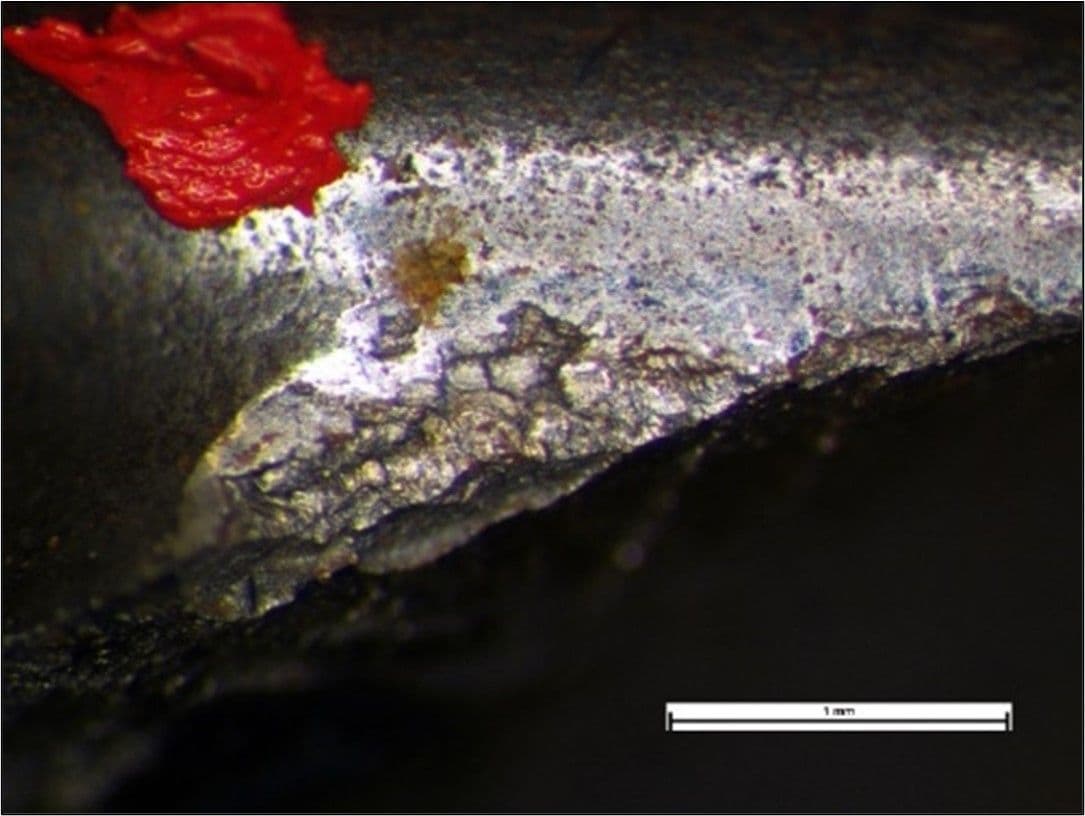Description
Impact is a high strain rate effect caused by the dynamic contact (collision) between two surfaces. Materials react differently under impact compared to static or slow loading rates. Impact by a given mass will generate greater energy than the same mass applied statically or at a slow loading rate.
Impact-fatigue is cracking or damage that occurs when a material is subjected to repeated impacts in a localised area. High strain rates generated in the material from an impact, are greater than that experienced in ‘normal’ fatigue (e.g. strain rate greater than 103s-1), which can lead to rapid onset of fatigue crack initiation
Impact-fatigue is usually applied to a condition where one surface is repeatedly impacted by another surface e.g. an object, and the resulting damage occurs at the point of contact. Failure caused by a single impact may occur directly at the impact site (e.g. a projectile making contact with a plate), or remote from it (e.g. a bar fixed at one end, with the impact applied to the other end leading to a bending moment and fracture at the fixed end).
Mechanism
A fracture that occurs from loading applied at a slow rate, sufficient to reach the breaking point of the material, would be called an overload fracture, but when the load is applied at a high rate the resulting fracture can be termed an impact fracture.
Rather than a failure mechanism per se, fracture due to a single impact event can occur by either brittle, ductile, or a combination of both fracture modes depending on the magnitude of the impact and the nature of the material. For example, crack growth modes will be affected by the rate of impact (strain rate), temperature, grain size, and heat treatment condition.
During impact, energy from the impacting object (a function of its mass and velocity) will be wholly or partially transferred into the impacted material. This increase in energy could cause the material to yield, and in the process of yielding it absorbs energy, or where no more energy can be absorbed, and fracture occurs; again, the process of fracture, where two new free surfaces are created, will absorb energy. If a material is highly ductile, or tough, large amounts of energy can be absorbed during the process of deformation, and potentially to a degree that can absorb all of the impact energy before fracture occurs. Conversely, a less tough or more brittle material will not exhibit much plastic deformation and energy can rapidly build up to the point of fracture.
Laboratory impact tests are routinely carried out on low alloy steels to determine if the heat treatment has been carried out correctly and have not been ‘temper embrittled’. An impact test would identify if the material was embrittled, whilst a ‘typical’ (low strain rate) tensile test would not.
Under repeated impacts, the material may undergo plastic deformation or result in small cracks at or just below the surface. As impacts continue, any plasticity in the material may start to reduce due to work hardening and the material gets harder (a process that is sometimes used deliberately to impart compressive stresses in the surface of a material to increase abrasion resistance but also resistance to fatigue). Eventually, the repeated loading can promote fatigue cracking, that often develops in the form of spalling where shallow sections or flakes of material detach from the surface.
Appearance
Laboratory-based impact tests usually consist of either the Charpy or Izod methods. A round or square section bar is exposed to an impact by a swinging pendulum and the amount of energy absorbed by the impact is measured. A brittle fracture will absorb minimal energy whilst a ductile fracture will absorb a correspondingly larger amount. In addition, the appearance of the fracture face will differ between the different fracture modes with a brittle fracture exhibiting a flat and crystalline appearance whilst a ductile fracture will exhibit some necking, deformation, and shear fracture lips at the edges. Further details on brittle and ductile fractures can be found in other white papers on the SureScreen Materials website.
Examples
SureScreen Materials were asked to undertake an investigation of the failure of drive dogs in a gearbox following testing on an engine test bed. On examination, the surfaces of the dogs were found to exhibit surface damage from repeated impacts with the mating surfaces of the opposing dogs. This developed into surface spalling as shown in the image below. The spalled (detached) sections of material then caused consequential damage elsewhere in the gears from this debris being drawn into the meshing gears.

However, as the surface spalling developed, due to the inherent cyclic loading and the stress concentrations presented by the spalled surfaces, fatigue cracks then propagated out into the bulk of the gear resulting in complete fracture as shown below.

The concentric linear marks, or ‘beach-marks’, so characteristic of the progressive nature of fatigue cracks are where the crack either arrests periodically or when there are major changes in stress condition. These radiate out from the point of initiation and so allow this location to be identified as marked by the red arrow.
Similar to fatigue, the resistance of a component to impact fatigue can be enhanced by surface hardening techniques such as carburising, nitriding, and compression of the surface layer such as by shot bombardment.
